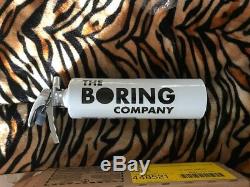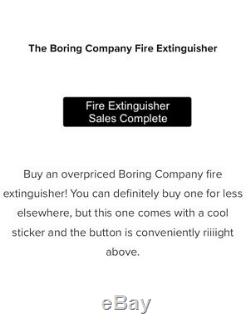The Boring Company Fire Extinguisher Sold Out Elon Musk, SpaceX, Tesla, TBC








Confirmed Pre-Order of The Boring Company Fire Extinguisher. This does not guarantee item will be delivered in Spring.
This piece is 100% Authentic from The Boring Comany. Tags: Elon Musk, SpaceX, Tesla, The Boring Company, SolarCity, Flamethrower, Fire Extinguisher, Elon, Musk, Firefighter, Collectible, Authentic. FAQ on The Boring Company.
To solve the problem of soul-destroying traffic, roads must go 3D, which means either flying cars or tunnels. Unlike flying cars, tunnels are weatherproof, out of sight and won't fall on your head.A large network of tunnels many levels deep would fix congestion in any city, no matter how large it grew (just keep adding levels). The key to making this work is increasing tunneling speed and dropping costs by a factor of 10 or more this is the goal of The Boring Company. Fast to dig, low cost tunnels would also make Hyperloop adoption viable and enable rapid transit across densely populated regions, enabling travel from New York to Washington DC in less than 30 minutes. To alleviate traffic, transportation corridors, like the buildings that feed into them, must expand into three dimensions.
One option is to go up with flying cars. However, flying cars have issues with weather, noise, and generally increase anxiety levels of those below them.
The other option is to go down and build tunnels. There is no practical limit to how many layers of tunnels can be built, so any level of traffic can be addressed.
Tunnel construction and operation are silent and invisible to anyone on the surface. Tunnels dont divide communities with lanes and barriers. Why hasn't this been done before?
In order to make a tunnel network feasible, tunneling costs must be reduced by a factor of more than 10. How can we reduce the cost of tunneling? First, reduce the tunnel diameter. The current standard for a one-lane tunnel is approximately 28 feet.
By placing vehicles on a stabilized electric skate, the diameter can be reduced to less than 14 feet. Reducing the diameter in half reduces tunneling costs by 3-4 times. Second, increase the speed of the Tunnel Boring Machine (TBM). A snail is effectively 14 times faster than a soft-soil TBM.Our goal is to defeat the snail in a race. Ways to increase TBM speed. The machines power output can be tripled (while coupled with the appropriate upgrades in cooling systems).
When building a tunnel, current soft-soil machines tunnel for 50% of the time and erect tunnel support structures the other 50%. Existing technology can be modified to support continuous tunneling activity. While smaller diameter tunneling machines are automated, larger ones currently require multiple human operators. By automating the larger TBMs, both safety and efficiency are increased.
Current tunnel operations often include diesel locomotives. These can be replaced by electric vehicles.
In the United States, there is virtually no investment in tunneling Research and Development (and in many other forms of construction). Thus, the construction industry is one of the only sectors in our economy that has not improved its productivity in the last 50 years. Tunnels, when designed properly, are known to be one of the safest places to be during an earthquake. From a structural safety standpoint, the tunnel moves uniformly with the ground, in contrast to surface structures. Additionally, a large amount of earthquake damage is caused by falling debris, which does not apply inside tunnels.1994 Northridge Earthquake: no damage to LA Subway tunnels. 1989 Loma Prieta (Northern California) Earthquake: no damage to tunnels, which were then used to transport rescue personnel. 1985 Mexico City Earthquake: no damage to tunnels, which were then used to transport rescue personnel. Is there disruptive surface vibration or noise during tunneling?
Once a TBM is below a certain depth (approximately two tunnel diameters or 28 feet in this case), the tunneling process is almost impossible to detect, especially in soft soil. What do you do with all that dirt? This process is costly, time-consuming, noisy, and can be environmentally hazardous. The Boring Company is investigating technologies that will recycle the earth into useful bricks to be used to build structures.
This is not a new concept, as buildings have been constructed from Earth for thousands of years including, according to recent evidence, the Pyramids. These bricks can potentially be used as a portion of the tunnel lining itself, which is typically built from concrete. Since concrete production accounts for 4.5% of the worlds greenhouse gas emissions, earth bricks would reduce both environmental impact and tunneling costs. Loop is a high-speed underground public transportation system in which passengers are transported on autonomous electric skates traveling at 125-150 miles per hour.
Electric skates will carry between 8 and 16 passengers (mass transit), or a single passenger vehicle. Hyperloop is an ultra high-speed underground public transportation system in which passengers are transported on autonomous electric pods traveling at 600+ miles per hour in a pressurized cabin.
Similar to Loop, Hyperloop pods will transport between 8 and 16 passengers (mass transit), or a single passenger vehicle. What's the difference between Loop and Hyperloop? Loop and Hyperloop are similar, with the major difference being that Hyperloop draws a vacuum inside the tube to eliminate air friction. Loop is used for shorter routes, when there is no technical need to eliminate air friction. How is this different from a subway?The electric skates are faster than conventional subway cars, and are autonomous vehicles. Most importantly, Loop is an express public transit system through the use of a main artery with side tunnels for entry/exit, passengers travel directly to their final destination without stopping. Therefore, unlike trains, the skates average speed is very close to its maximum speed. How will you avoid major congestion at entry/exit points? Unlike a subway, there is no practical upper limit to the number of stations that can be built along the tunnel route, as stations can be as small as a single parking space.
Each station will consist of a bank of elevators and the number of elevators is only limited to the available land area. The electric skates will descend into a "spur" or tunnel offshoot before quickly merging into the tunnel network. Since stations require such a small footprint, they can be easily integrated in busy city-centers, residential communities, or any location along the tunnel route that can accommodate a single parking space.
The high density of stations will help reduce congestion by distributing traffic across many access points and by providing more convenient entrance and exit locations. At the same time, larger elevator banks can be built near public transportation hubs to connect with existing systems. What is an electric skate and why use it?An electric skate is a platform on wheels propelled by multiple electric motors. As discussed above, the electric skate allows a large reduction in tunnel diameter, in addition to.
A fully stabilized autonomous vehicle eliminates human error and the ability to swerve off-course. The controlled autonomous skate allows for speeds of 125 - 150 miles per hour in urban settings. The electric skate can transport people (mass transit), goods and/or automobiles.And if one adds a vacuum shell, it is now a Hyperloop pod which can travel at 600+ miles per hour. Electric skates are zero-emission vehicles, and thus do not output hazardous gases like internal combustion cars do. Every mile the skate transports a gas-burning vehicle becomes a zero-emission mile.
Which projects are in the works? Hawthorne: an initial test tunnel has been permitted and is under construction. Los Angeles: an excavation permit application has been submitted to the City of Los Angeles. The proposed project would be a 6.5 mile proof-of-process tunnel which would run within the City of Los Angeles and Culver City.
East Coast: The Boring Company is working with federal and state officials on a DC-to-Baltimore route, which would then be extended to New York. In a promising first step, the State of Maryland has granted permission for 10.1 miles of tunnel beneath the state-owned portion of the Baltimore-Washington Parkway. Chicago: The Boring Company is responding to the RFQ released by the City of Chicago to compete to fund, build and operate a high-speed Loop connecting Chicago OHare Airport to downtown. Can you share any more about the LA tunnel? Yes, check out this map. Red shows the proposed Phase 1 proof-of-process tunnel for which The Boring Company has filed an excavation permit application. Phase 1 would include the construction of a 6.5-mile proof-of-process tunnel through Los Angeles and Culver City.The tunnel would be used for construction logistics verification, system testing, safety testing, operating procedure verification, and line-switching demonstrations. Phase 1 would not be utilized for public transportation until the proof-of-process tunnel is deemed successful by County government, City government, and TBC. Blue indicates potential Phase 2 expansion options, and is included as a concept, not as a finalized alignment.
Phase 2 specifics would be developed in cooperation with Los Angeles County, the City of Los Angeles, city governments in the greater Los Angeles area, and the general public. The Boring Company looks forward to receiving feedback from residents of the greater Los Angeles area on station locations and system improvements for Phase 2 and beyond. Are you seeking public funding? No, The Boring Company is privately funded and our individual projects will be privately funded as well. How do I get a tunnel in my city? While a tunnel project is a complex multi-step process, the first step is finding two great endpoints and an alignment between them! The item "The Boring Company Fire Extinguisher Sold Out Elon Musk, SpaceX, Tesla, TBC" is in sale since Tuesday, March 13, 2018. This item is in the category "Collectibles\Historical Memorabilia\Firefighting & Rescue\Extinguishers". The seller is "vintagerimowa" and is located in Los Angeles, California. This item can be shipped to United States.
- Country/Region of Manufacture: Unknown

